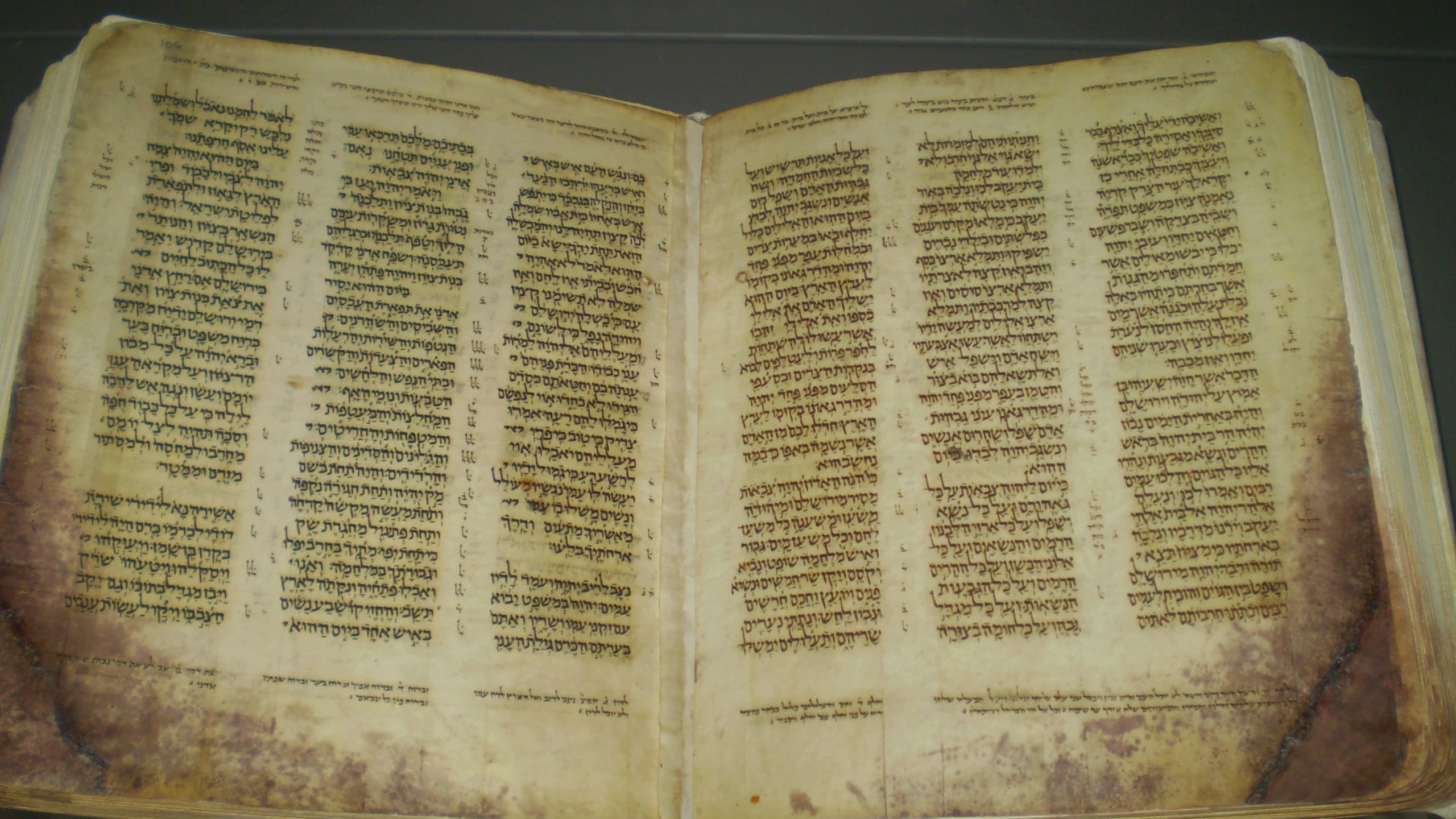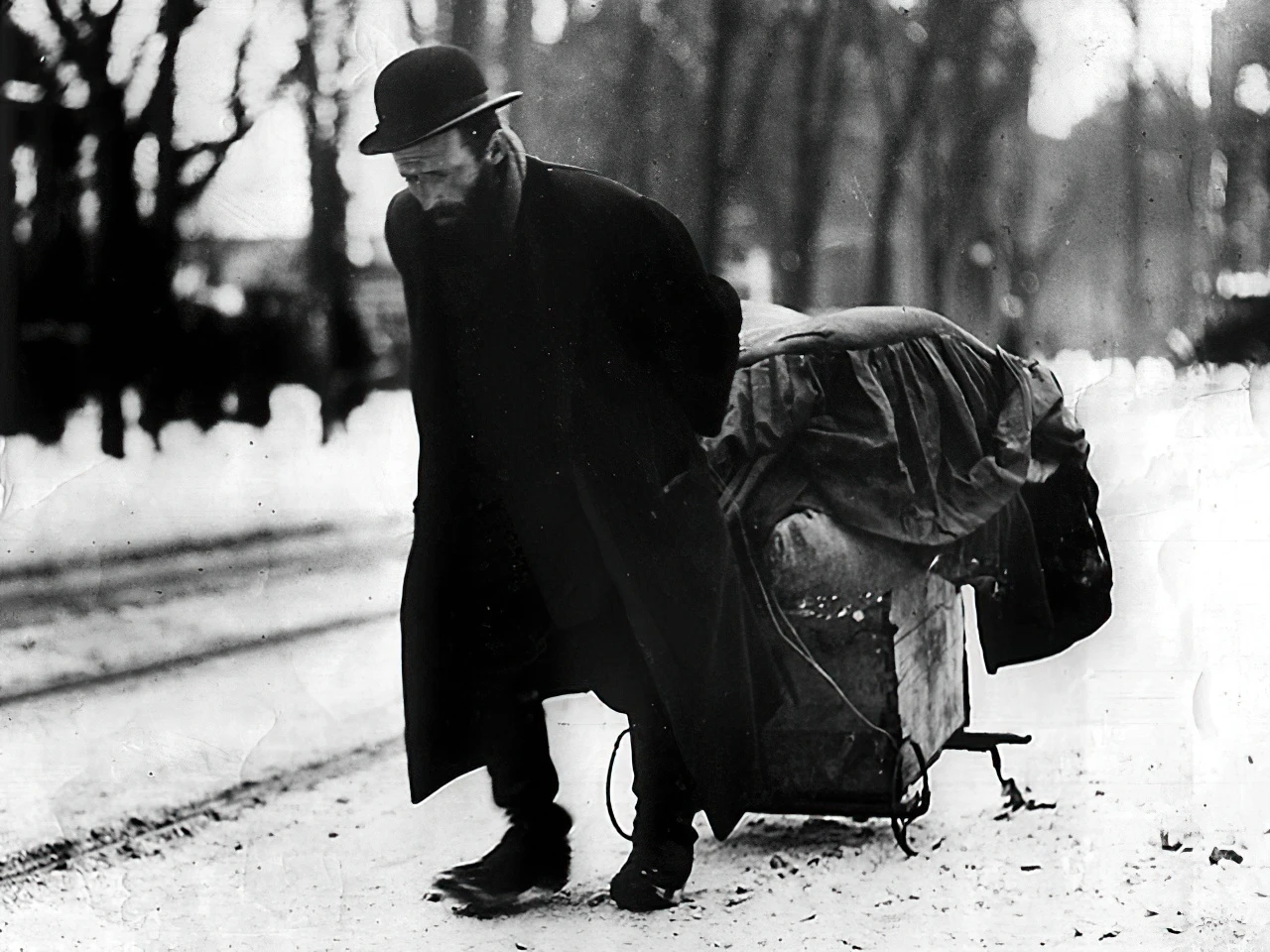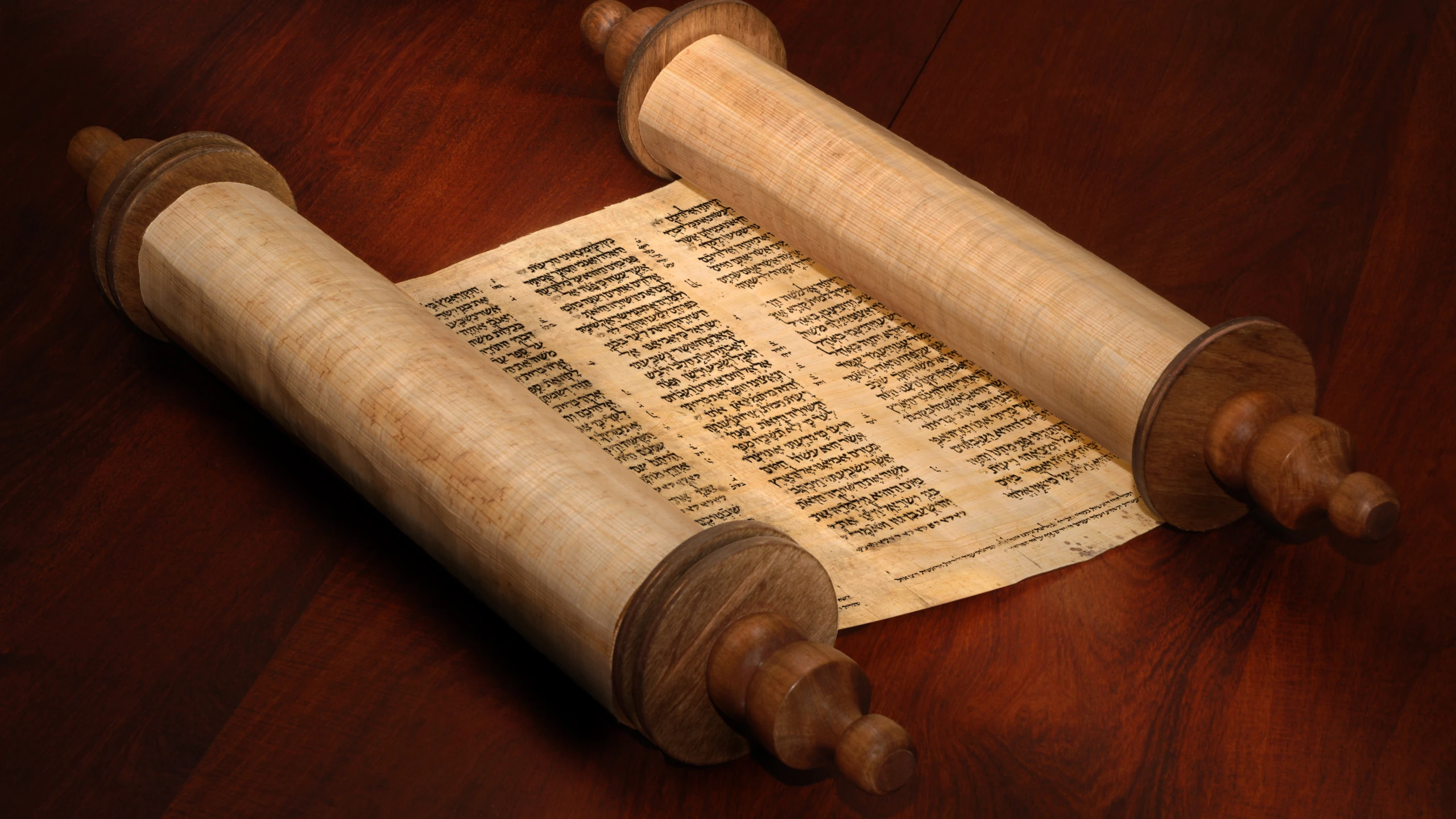The Crown of Aleppo
The Incredible Loss & Recovery of the Most Authoritative Tanach Manuscript
- May 13, 2021
- |
- 2 Sivan 5781
Rabbi YY Jacobson
1860 צפיות
A page of the Codex of Aleppo

The Crown of Aleppo
The Incredible Loss & Recovery of the Most Authoritative Tanach Manuscript
Rabbi YY Jacobson
- May 13, 2021
The Bet on David and Goliath
An archaeologist was digging in the Negev Desert in Israel and came upon a casket containing a mummy. After examining it, he called the curator of a prestigious natural history museum.
"I've just discovered a 3,000-year-old mummy of a man who died of heart failure!" the excited scientist exclaimed.
The curator replied, "Bring him in. We'll check it out."
A week later, the amazed curator called the archaeologist. "You were right about the mummy's age and cause of death. How in the world did you know?"
"Easy. There was a piece of paper in his hand that said, '1 million Shekel on Goliath'."
The Story of the Codex
Secured in the lower level of the famed Shrine of the Book at Jerusalem’s Israel Museum sits the Aleppo Codex. Its story is thrilling and mysterious, mirroring the story of the people who authored the Codex, the oldest, most complete, most accurate text of the Hebrew Bible, preserved in its entirety in important Jewish communities in the Near East: Tiberias, Jerusalem, Egypt, and in the city of Aleppo, Syria.
As we celebrate this holiday of Shavuos when we were given the Torah, it is worth recalling this story.
Some call it the Aleppo Codex, some call it the Crown of Aleppo. Its Hebrew name is כֶּתֶר אֲרָם צוֹבָא (Keter Aram Tzova), the "Crown of Aleppo."
What is its uniqueness? This manuscript of the Hebrew Bible—the Tanach—was written around the year 930 by the scribe Shlomo ben Buya and was annotated (with the vowels—nekudos—and cantillations—trup—of the entire Tanach) by Aharon ben Asher. Aharon was considered the greatest expert on biblical texts and devoted his entire life to researching the most accurate version of the Tanach. How is each word spelled? What is its exact pronunciation? What is the musical note with which it is read in shul? How exactly is it written in the Torah Scroll? Although all Torah scrolls were copied from a previous one since there was no printing at the time, all were copied by hand, and over millennia, a mistake here or there creeps in. Aharon ben Asher spent a lifetime discovering the most authoritative text—and it was this Codex that he edited, time and time and time again until he perfected it.
Despite its name, the Keter (the Aleppo Codex) was not written in Aleppo, but in the northern Israeli city of Tiberias. Soon thereafter, the Keter would travel to Jerusalem and quickly become the authoritative text of the Bible for Jews and non-Jews alike.
Now, if you know your history, you know that eleventh-century Jerusalem was no place for a nice Jewish boy or a Jewish Bible. When Jerusalem was ransacked by the Christian Crusaders, the Keter was saved and ransomed from the Crusaders by Jews of Egypt.
In Fustat, Egypt, the Keter came into the possession of the most famous Jew of the day and perhaps of all times – Rabbi Moses Maimonides, the Rambam (1135-1204).
Before his passing in 1204, Maimonides, upon whose contributions to Jewish law, philosophy, and exegesis we still rely, referred to the Keter as the authoritative text of the Bible.
רמב"ם הלכות ספר תורה פרק ח הלכה ד: וספר שסמכנו עליו בדברים אלו הוא הספר הידוע במצרים שהוא כולל ארבעה ועשרים ספרים שהיה בירושלים מכמה שנים להגיה ממנו הספרים, ועליו היו הכל סומכין, לפי שהגיהו בן אשר ודקדק בו שנים הרבה והגיהו פעמים רבות כמו שהעתיקוּ, ועליו סמכתי בספר התורה שכתבתי כהלכתו.
And the book that we relied upon in these matters is the well-known book in Egypt, which contains twenty-four books, which was in Jerusalem some years ago, to revise the books from it, and everyone relied on it since it was revised by Aharon ben Asher, and he worked meticulously on it for many years and revised it many times, as they copied, and I have relied on it in the Torah Scroll that I wrote according to the Halakha.
Here Maimonides is telling us of a complete manuscript of the Bible (twenty-four books), which was revised by Aharon ben Asher over and over again for many years. Maimonides prefers this manuscript to all the other Torah Scrolls and manuscripts, and he decrees as Halacha that Torah scrolls should be written according to this manuscript. Because of the great authority of Maimonides, within a few generations, all Jewish communities accepted his ruling, and all the Torah scrolls of all the Jewish ethnic groups are written according to his instructions, which are based on the codex revised by Aharon ben Asher.
Now, you must understand the significance of this. Maimonides transcribed in his code of law the accurate way the Torah scroll must be transcribed—and it was all from this Codex that fell into his hands and which he trusted more than any other scroll.
As to how the Keter arrived from Egypt to Syria, we are not sure. We know that Rabbi Dovid ben Yehoshua, a direct descendant of Maimonides, traveled through Israel in 1375, going to live in Damascus and eventually Aleppo, a historically strong and rich Jewish community. Some speculated he might have brought it to Syria.
There the Keter sat, in the old Aleppo Synagogue, for over five hundred years, in a chest with two locks, like a nuclear briefcase, not to be opened except in the presence of the bearers of the keys. Two leaders of the community had the keys, but the pact was that nobody would open it not in the presence of the other.
The Riots
The Keter slumbered for centuries – a sacred text under the protectorate of the Aleppo community – right up until November 30, 1947, the morning after the UN General Assembly voted in favor of the establishment of a Jewish State.
That morning a mob attacked the Jewish quarter in Aleppo, setting fire to the synagogues, the start of a riot that would go on for days. The attack, a part of an anti-Jewish wave of unrest across the Middle East and North Africa, resulted in some 75 Jews murdered and several hundred wounded. Following the attack, the Jewish community went into a steep decline. The wealthy Jews escaped the day after the pogrom and many more fled in small groups in subsequent months. Their property was forfeited and on December 22 the Syrian Government enacted a law forbidding Jews from selling their property. Within a few years after the pogroms, most Jews left Aleppo, a large majority of them relocating to Israel. By 1959, about 2,000 Jews remained in Aleppo. As of 2012, no Jews live in Aleppo.
What about the Crown stored away in the synagogue that was attacked? At first, people thought that it had been completely destroyed. Later, however, it turned out that most of the manuscript had been saved. The synagogue sexton, Asher Baghdadi, and his son ran back into the smoldering synagogue to gather the pages of the Crown!
From that day on, the writing was on the wall for the Aleppo Community. For ten years, the Keter went from hiding place to hiding place. It traveled from hand to hand, hiding it from the Syrian authorities. Eventually, in 1958 the Codex was wrapped in cheesecloth and smuggled out by a dairyman to the fledgling new State of Israel. It arrived in Jerusalem and was delivered to the President of Israel, Yitzchak Ben Zvi.
The Missing Pages
The Aleppo Codex originally had 487 pages. Yet, as it reached Israel, it had only 294 parchment pages, written on both sides. Examinations revealed that many pages were missing because of the damage to the Codex during the 1947 pogrom. Mainly the first part of the manuscript was damaged, the Pentateuch (the Five Books of Moses), of which only the last eleven pages remained. Almost all the Chumash (Five Books of Moses) had been lost, except the final chapters of the Book of Deuteronomy, which were preserved.
Many efforts were made to locate the missing pages of the Aleppo Codex. Despite years of research, and all of types of mysterious and criminal stories circulating, we do not know what happened to the missing pages. Were they burned or destroyed? Were they, perhaps, hidden somewhere? Were they stolen? Did Jewish families from Aleppo take them?
The efforts to ascertain the truth met with many disappointments. Nevertheless, there were two successes: an entire page of the Aleppo Codex from the book of Chronicles reached New York and was preserved by a family from the city of Aleppo. Eventually, that page was given to the National Library in Jerusalem and added to the Aleppo Codex. Then another clue was discovered: a fragment of a page from the Book of Exodus had been preserved in the United States in the wallet of a man from Aleppo, who used it as a kind of lucky charm. This piece of parchment has not yet reached Jerusalem, but a photograph of it has been published.
Today one can see the Codex—whatever parts they found—in the Israel Museum. Its silent pages tell an incredible story, the story not only of a manuscript but of a people holding on to its Torah for the last 3,333 years.
The Soul of a People
In my mind, this narrative captures the story of our people. The book has been the soul of the people, and the people have been the soul of the book.
Just like the Crown of Aleppo, we too traveled from country to country, yet we held on to our Torah, and it held on to us. As a result, we retained our identity if sometimes only in fragments, ultimately returning—like the Codex—to our eternal homeland.
Just like the Crown of Aleppo, they said about us too that we are no more; that we have been destroyed. But in some inexplicable way, 3333 years after Sinai we are still going strong.
The Jewish people are under attack again. Three millennia later, our foes still crave genocide for the Jews, and the world blames the Jews…
We must stand united and strong and always remember that as long as we hold on to the book, eternity belongs to us.
(My thanks to Rabbi Nir Gurevitch, Spiritual leader, Surfers Paradise, Australia, for his assistance with this essay).
- תגובה
סיכום השיעור:
Secured in the lower level of the famed Shrine of the Book at Jerusalem’s Israel Museum sits the Aleppo Codex. Its story is thrilling and mysterious, mirroring the story of the people who authored the Codex, the oldest, most complete, most accurate text of the Hebrew Bible, preserved in its entirety in important Jewish communities in the Near East: Tiberias, Jerusalem, Egypt, and in the city of Aleppo in Syria. As we celebrate this holiday when we were given the Torah, it is worth recalling this story.
The Keter (the Aleppo Codex) slumbered for centuries – a sacred text under the protectorate of the Aleppo community – right up until November 30, 1947, the morning after the UN General Assembly voted in favor of the establishment of a Jewish State. That morning a mob attacked the Jewish quarter in Aleppo, setting fire to the synagogues, the start of a riot that would go on for days.
At first, people thought that it had been completely destroyed. Later, however, it turned out that most of the manuscript had been saved. The synagogue sexton, Asher Baghdadi, and his son ran back into the smoldering synagogue to gather the pages of the Crown. Eventually, in 1958 the codex was wrapped in cheesecloth and smuggled out by a dairyman to the fledgling new State of Israel. It arrived in Jerusalem and was delivered to the President of Israel, Yitzchak Ben Zvi.
The incredible story of this Codex mirrors the story of our people.
Dedicated in memory of Miriam bas R’ Boruch Avrohom Fischer
The Bet on David and Goliath
An archaeologist was digging in the Negev Desert in Israel and came upon a casket containing a mummy. After examining it, he called the curator of a prestigious natural history museum.
"I've just discovered a 3,000-year-old mummy of a man who died of heart failure!" the excited scientist exclaimed.
The curator replied, "Bring him in. We'll check it out."
A week later, the amazed curator called the archaeologist. "You were right about the mummy's age and cause of death. How in the world did you know?"
"Easy. There was a piece of paper in his hand that said, '1 million Shekel on Goliath'."
The Story of the Codex
Secured in the lower level of the famed Shrine of the Book at Jerusalem’s Israel Museum sits the Aleppo Codex. Its story is thrilling and mysterious, mirroring the story of the people who authored the Codex, the oldest, most complete, most accurate text of the Hebrew Bible, preserved in its entirety in important Jewish communities in the Near East: Tiberias, Jerusalem, Egypt, and in the city of Aleppo, Syria.
As we celebrate this holiday of Shavuos when we were given the Torah, it is worth recalling this story.
Some call it the Aleppo Codex, some call it the Crown of Aleppo. Its Hebrew name is כֶּתֶר אֲרָם צוֹבָא (Keter Aram Tzova), the "Crown of Aleppo."
What is its uniqueness? This manuscript of the Hebrew Bible—the Tanach—was written around the year 930 by the scribe Shlomo ben Buya and was annotated (with the vowels—nekudos—and cantillations—trup—of the entire Tanach) by Aharon ben Asher. Aharon was considered the greatest expert on biblical texts and devoted his entire life to researching the most accurate version of the Tanach. How is each word spelled? What is its exact pronunciation? What is the musical note with which it is read in shul? How exactly is it written in the Torah Scroll? Although all Torah scrolls were copied from a previous one since there was no printing at the time, all were copied by hand, and over millennia, a mistake here or there creeps in. Aharon ben Asher spent a lifetime discovering the most authoritative text—and it was this Codex that he edited, time and time and time again until he perfected it.
Despite its name, the Keter (the Aleppo Codex) was not written in Aleppo, but in the northern Israeli city of Tiberias. Soon thereafter, the Keter would travel to Jerusalem and quickly become the authoritative text of the Bible for Jews and non-Jews alike.
Now, if you know your history, you know that eleventh-century Jerusalem was no place for a nice Jewish boy or a Jewish Bible. When Jerusalem was ransacked by the Christian Crusaders, the Keter was saved and ransomed from the Crusaders by Jews of Egypt.
In Fustat, Egypt, the Keter came into the possession of the most famous Jew of the day and perhaps of all times – Rabbi Moses Maimonides, the Rambam (1135-1204).
Before his passing in 1204, Maimonides, upon whose contributions to Jewish law, philosophy, and exegesis we still rely, referred to the Keter as the authoritative text of the Bible.
רמב"ם הלכות ספר תורה פרק ח הלכה ד: וספר שסמכנו עליו בדברים אלו הוא הספר הידוע במצרים שהוא כולל ארבעה ועשרים ספרים שהיה בירושלים מכמה שנים להגיה ממנו הספרים, ועליו היו הכל סומכין, לפי שהגיהו בן אשר ודקדק בו שנים הרבה והגיהו פעמים רבות כמו שהעתיקוּ, ועליו סמכתי בספר התורה שכתבתי כהלכתו.
And the book that we relied upon in these matters is the well-known book in Egypt, which contains twenty-four books, which was in Jerusalem some years ago, to revise the books from it, and everyone relied on it since it was revised by Aharon ben Asher, and he worked meticulously on it for many years and revised it many times, as they copied, and I have relied on it in the Torah Scroll that I wrote according to the Halakha.
Here Maimonides is telling us of a complete manuscript of the Bible (twenty-four books), which was revised by Aharon ben Asher over and over again for many years. Maimonides prefers this manuscript to all the other Torah Scrolls and manuscripts, and he decrees as Halacha that Torah scrolls should be written according to this manuscript. Because of the great authority of Maimonides, within a few generations, all Jewish communities accepted his ruling, and all the Torah scrolls of all the Jewish ethnic groups are written according to his instructions, which are based on the codex revised by Aharon ben Asher.
Now, you must understand the significance of this. Maimonides transcribed in his code of law the accurate way the Torah scroll must be transcribed—and it was all from this Codex that fell into his hands and which he trusted more than any other scroll.
As to how the Keter arrived from Egypt to Syria, we are not sure. We know that Rabbi Dovid ben Yehoshua, a direct descendant of Maimonides, traveled through Israel in 1375, going to live in Damascus and eventually Aleppo, a historically strong and rich Jewish community. Some speculated he might have brought it to Syria.
There the Keter sat, in the old Aleppo Synagogue, for over five hundred years, in a chest with two locks, like a nuclear briefcase, not to be opened except in the presence of the bearers of the keys. Two leaders of the community had the keys, but the pact was that nobody would open it not in the presence of the other.
The Riots
The Keter slumbered for centuries – a sacred text under the protectorate of the Aleppo community – right up until November 30, 1947, the morning after the UN General Assembly voted in favor of the establishment of a Jewish State.
That morning a mob attacked the Jewish quarter in Aleppo, setting fire to the synagogues, the start of a riot that would go on for days. The attack, a part of an anti-Jewish wave of unrest across the Middle East and North Africa, resulted in some 75 Jews murdered and several hundred wounded. Following the attack, the Jewish community went into a steep decline. The wealthy Jews escaped the day after the pogrom and many more fled in small groups in subsequent months. Their property was forfeited and on December 22 the Syrian Government enacted a law forbidding Jews from selling their property. Within a few years after the pogroms, most Jews left Aleppo, a large majority of them relocating to Israel. By 1959, about 2,000 Jews remained in Aleppo. As of 2012, no Jews live in Aleppo.
What about the Crown stored away in the synagogue that was attacked? At first, people thought that it had been completely destroyed. Later, however, it turned out that most of the manuscript had been saved. The synagogue sexton, Asher Baghdadi, and his son ran back into the smoldering synagogue to gather the pages of the Crown!
From that day on, the writing was on the wall for the Aleppo Community. For ten years, the Keter went from hiding place to hiding place. It traveled from hand to hand, hiding it from the Syrian authorities. Eventually, in 1958 the Codex was wrapped in cheesecloth and smuggled out by a dairyman to the fledgling new State of Israel. It arrived in Jerusalem and was delivered to the President of Israel, Yitzchak Ben Zvi.
The Missing Pages
The Aleppo Codex originally had 487 pages. Yet, as it reached Israel, it had only 294 parchment pages, written on both sides. Examinations revealed that many pages were missing because of the damage to the Codex during the 1947 pogrom. Mainly the first part of the manuscript was damaged, the Pentateuch (the Five Books of Moses), of which only the last eleven pages remained. Almost all the Chumash (Five Books of Moses) had been lost, except the final chapters of the Book of Deuteronomy, which were preserved.
Many efforts were made to locate the missing pages of the Aleppo Codex. Despite years of research, and all of types of mysterious and criminal stories circulating, we do not know what happened to the missing pages. Were they burned or destroyed? Were they, perhaps, hidden somewhere? Were they stolen? Did Jewish families from Aleppo take them?
The efforts to ascertain the truth met with many disappointments. Nevertheless, there were two successes: an entire page of the Aleppo Codex from the book of Chronicles reached New York and was preserved by a family from the city of Aleppo. Eventually, that page was given to the National Library in Jerusalem and added to the Aleppo Codex. Then another clue was discovered: a fragment of a page from the Book of Exodus had been preserved in the United States in the wallet of a man from Aleppo, who used it as a kind of lucky charm. This piece of parchment has not yet reached Jerusalem, but a photograph of it has been published.
Today one can see the Codex—whatever parts they found—in the Israel Museum. Its silent pages tell an incredible story, the story not only of a manuscript but of a people holding on to its Torah for the last 3,333 years.
The Soul of a People
In my mind, this narrative captures the story of our people. The book has been the soul of the people, and the people have been the soul of the book.
Just like the Crown of Aleppo, we too traveled from country to country, yet we held on to our Torah, and it held on to us. As a result, we retained our identity if sometimes only in fragments, ultimately returning—like the Codex—to our eternal homeland.
Just like the Crown of Aleppo, they said about us too that we are no more; that we have been destroyed. But in some inexplicable way, 3333 years after Sinai we are still going strong.
The Jewish people are under attack again. Three millennia later, our foes still crave genocide for the Jews, and the world blames the Jews…
We must stand united and strong and always remember that as long as we hold on to the book, eternity belongs to us.
(My thanks to Rabbi Nir Gurevitch, Spiritual leader, Surfers Paradise, Australia, for his assistance with this essay).
Shavuos Essay
Rabbi YY Jacobson
- May 13, 2021
- |
- 2 Sivan 5781
- |
- 1860 צפיות

The Crown of Aleppo
The Incredible Loss & Recovery of the Most Authoritative Tanach Manuscript
Rabbi YY Jacobson
- May 13, 2021
The Bet on David and Goliath
An archaeologist was digging in the Negev Desert in Israel and came upon a casket containing a mummy. After examining it, he called the curator of a prestigious natural history museum.
"I've just discovered a 3,000-year-old mummy of a man who died of heart failure!" the excited scientist exclaimed.
The curator replied, "Bring him in. We'll check it out."
A week later, the amazed curator called the archaeologist. "You were right about the mummy's age and cause of death. How in the world did you know?"
"Easy. There was a piece of paper in his hand that said, '1 million Shekel on Goliath'."
The Story of the Codex
Secured in the lower level of the famed Shrine of the Book at Jerusalem’s Israel Museum sits the Aleppo Codex. Its story is thrilling and mysterious, mirroring the story of the people who authored the Codex, the oldest, most complete, most accurate text of the Hebrew Bible, preserved in its entirety in important Jewish communities in the Near East: Tiberias, Jerusalem, Egypt, and in the city of Aleppo, Syria.
As we celebrate this holiday of Shavuos when we were given the Torah, it is worth recalling this story.
Some call it the Aleppo Codex, some call it the Crown of Aleppo. Its Hebrew name is כֶּתֶר אֲרָם צוֹבָא (Keter Aram Tzova), the "Crown of Aleppo."
What is its uniqueness? This manuscript of the Hebrew Bible—the Tanach—was written around the year 930 by the scribe Shlomo ben Buya and was annotated (with the vowels—nekudos—and cantillations—trup—of the entire Tanach) by Aharon ben Asher. Aharon was considered the greatest expert on biblical texts and devoted his entire life to researching the most accurate version of the Tanach. How is each word spelled? What is its exact pronunciation? What is the musical note with which it is read in shul? How exactly is it written in the Torah Scroll? Although all Torah scrolls were copied from a previous one since there was no printing at the time, all were copied by hand, and over millennia, a mistake here or there creeps in. Aharon ben Asher spent a lifetime discovering the most authoritative text—and it was this Codex that he edited, time and time and time again until he perfected it.
Despite its name, the Keter (the Aleppo Codex) was not written in Aleppo, but in the northern Israeli city of Tiberias. Soon thereafter, the Keter would travel to Jerusalem and quickly become the authoritative text of the Bible for Jews and non-Jews alike.
Now, if you know your history, you know that eleventh-century Jerusalem was no place for a nice Jewish boy or a Jewish Bible. When Jerusalem was ransacked by the Christian Crusaders, the Keter was saved and ransomed from the Crusaders by Jews of Egypt.
In Fustat, Egypt, the Keter came into the possession of the most famous Jew of the day and perhaps of all times – Rabbi Moses Maimonides, the Rambam (1135-1204).
Before his passing in 1204, Maimonides, upon whose contributions to Jewish law, philosophy, and exegesis we still rely, referred to the Keter as the authoritative text of the Bible.
רמב"ם הלכות ספר תורה פרק ח הלכה ד: וספר שסמכנו עליו בדברים אלו הוא הספר הידוע במצרים שהוא כולל ארבעה ועשרים ספרים שהיה בירושלים מכמה שנים להגיה ממנו הספרים, ועליו היו הכל סומכין, לפי שהגיהו בן אשר ודקדק בו שנים הרבה והגיהו פעמים רבות כמו שהעתיקוּ, ועליו סמכתי בספר התורה שכתבתי כהלכתו.
And the book that we relied upon in these matters is the well-known book in Egypt, which contains twenty-four books, which was in Jerusalem some years ago, to revise the books from it, and everyone relied on it since it was revised by Aharon ben Asher, and he worked meticulously on it for many years and revised it many times, as they copied, and I have relied on it in the Torah Scroll that I wrote according to the Halakha.
Here Maimonides is telling us of a complete manuscript of the Bible (twenty-four books), which was revised by Aharon ben Asher over and over again for many years. Maimonides prefers this manuscript to all the other Torah Scrolls and manuscripts, and he decrees as Halacha that Torah scrolls should be written according to this manuscript. Because of the great authority of Maimonides, within a few generations, all Jewish communities accepted his ruling, and all the Torah scrolls of all the Jewish ethnic groups are written according to his instructions, which are based on the codex revised by Aharon ben Asher.
Now, you must understand the significance of this. Maimonides transcribed in his code of law the accurate way the Torah scroll must be transcribed—and it was all from this Codex that fell into his hands and which he trusted more than any other scroll.
As to how the Keter arrived from Egypt to Syria, we are not sure. We know that Rabbi Dovid ben Yehoshua, a direct descendant of Maimonides, traveled through Israel in 1375, going to live in Damascus and eventually Aleppo, a historically strong and rich Jewish community. Some speculated he might have brought it to Syria.
There the Keter sat, in the old Aleppo Synagogue, for over five hundred years, in a chest with two locks, like a nuclear briefcase, not to be opened except in the presence of the bearers of the keys. Two leaders of the community had the keys, but the pact was that nobody would open it not in the presence of the other.
The Riots
The Keter slumbered for centuries – a sacred text under the protectorate of the Aleppo community – right up until November 30, 1947, the morning after the UN General Assembly voted in favor of the establishment of a Jewish State.
That morning a mob attacked the Jewish quarter in Aleppo, setting fire to the synagogues, the start of a riot that would go on for days. The attack, a part of an anti-Jewish wave of unrest across the Middle East and North Africa, resulted in some 75 Jews murdered and several hundred wounded. Following the attack, the Jewish community went into a steep decline. The wealthy Jews escaped the day after the pogrom and many more fled in small groups in subsequent months. Their property was forfeited and on December 22 the Syrian Government enacted a law forbidding Jews from selling their property. Within a few years after the pogroms, most Jews left Aleppo, a large majority of them relocating to Israel. By 1959, about 2,000 Jews remained in Aleppo. As of 2012, no Jews live in Aleppo.
What about the Crown stored away in the synagogue that was attacked? At first, people thought that it had been completely destroyed. Later, however, it turned out that most of the manuscript had been saved. The synagogue sexton, Asher Baghdadi, and his son ran back into the smoldering synagogue to gather the pages of the Crown!
From that day on, the writing was on the wall for the Aleppo Community. For ten years, the Keter went from hiding place to hiding place. It traveled from hand to hand, hiding it from the Syrian authorities. Eventually, in 1958 the Codex was wrapped in cheesecloth and smuggled out by a dairyman to the fledgling new State of Israel. It arrived in Jerusalem and was delivered to the President of Israel, Yitzchak Ben Zvi.
The Missing Pages
The Aleppo Codex originally had 487 pages. Yet, as it reached Israel, it had only 294 parchment pages, written on both sides. Examinations revealed that many pages were missing because of the damage to the Codex during the 1947 pogrom. Mainly the first part of the manuscript was damaged, the Pentateuch (the Five Books of Moses), of which only the last eleven pages remained. Almost all the Chumash (Five Books of Moses) had been lost, except the final chapters of the Book of Deuteronomy, which were preserved.
Many efforts were made to locate the missing pages of the Aleppo Codex. Despite years of research, and all of types of mysterious and criminal stories circulating, we do not know what happened to the missing pages. Were they burned or destroyed? Were they, perhaps, hidden somewhere? Were they stolen? Did Jewish families from Aleppo take them?
The efforts to ascertain the truth met with many disappointments. Nevertheless, there were two successes: an entire page of the Aleppo Codex from the book of Chronicles reached New York and was preserved by a family from the city of Aleppo. Eventually, that page was given to the National Library in Jerusalem and added to the Aleppo Codex. Then another clue was discovered: a fragment of a page from the Book of Exodus had been preserved in the United States in the wallet of a man from Aleppo, who used it as a kind of lucky charm. This piece of parchment has not yet reached Jerusalem, but a photograph of it has been published.
Today one can see the Codex—whatever parts they found—in the Israel Museum. Its silent pages tell an incredible story, the story not only of a manuscript but of a people holding on to its Torah for the last 3,333 years.
The Soul of a People
In my mind, this narrative captures the story of our people. The book has been the soul of the people, and the people have been the soul of the book.
Just like the Crown of Aleppo, we too traveled from country to country, yet we held on to our Torah, and it held on to us. As a result, we retained our identity if sometimes only in fragments, ultimately returning—like the Codex—to our eternal homeland.
Just like the Crown of Aleppo, they said about us too that we are no more; that we have been destroyed. But in some inexplicable way, 3333 years after Sinai we are still going strong.
The Jewish people are under attack again. Three millennia later, our foes still crave genocide for the Jews, and the world blames the Jews…
We must stand united and strong and always remember that as long as we hold on to the book, eternity belongs to us.
(My thanks to Rabbi Nir Gurevitch, Spiritual leader, Surfers Paradise, Australia, for his assistance with this essay).
- תגובה
Dedicated in memory of Miriam bas R’ Boruch Avrohom Fischer
סיכום השיעור:
Secured in the lower level of the famed Shrine of the Book at Jerusalem’s Israel Museum sits the Aleppo Codex. Its story is thrilling and mysterious, mirroring the story of the people who authored the Codex, the oldest, most complete, most accurate text of the Hebrew Bible, preserved in its entirety in important Jewish communities in the Near East: Tiberias, Jerusalem, Egypt, and in the city of Aleppo in Syria. As we celebrate this holiday when we were given the Torah, it is worth recalling this story.
The Keter (the Aleppo Codex) slumbered for centuries – a sacred text under the protectorate of the Aleppo community – right up until November 30, 1947, the morning after the UN General Assembly voted in favor of the establishment of a Jewish State. That morning a mob attacked the Jewish quarter in Aleppo, setting fire to the synagogues, the start of a riot that would go on for days.
At first, people thought that it had been completely destroyed. Later, however, it turned out that most of the manuscript had been saved. The synagogue sexton, Asher Baghdadi, and his son ran back into the smoldering synagogue to gather the pages of the Crown. Eventually, in 1958 the codex was wrapped in cheesecloth and smuggled out by a dairyman to the fledgling new State of Israel. It arrived in Jerusalem and was delivered to the President of Israel, Yitzchak Ben Zvi.
The incredible story of this Codex mirrors the story of our people.
שיעורים קשורים
אנא עזרו לנו להמשיך בפעילותנו
הרשמה לקבלת תוכן (באנגלית) עדכני מאת הרב יוסף יצחק ג'ייקובסון
צרפו חברים ומשפחה לקבוצת הווסטאפ שלנו
צרפו חברים ומשפחה לקבוצת הווסטאפ שלנו






.webp)







אנא השאירו את תגובתכם למטה!
Adiv Shlomo Abramson -3 שנים לִפנֵי
תודה רבה על המאמר המענין הזה. רצוני לשאול למה אומרים בתחילת קריאת התורה בבית הכנסת "וזאת התורה אשר שם משה לפני בני ישראל על פי ה' ביד משה" כאשר אין לנו טקסט מלא ומוגה בידינו? ועוד אם התורה דברי ה' למה הוא לא שמר את ספר התורה אשר כתב משה (ויהושוע) באופן למעלה מן הטבע כדי שיכולים להעתיק ספרי תורה אחרים ממנו בלי שום ספקות וחריגות?
נראה לי שאנו אומרים דברי שקר כאשר אומרים שספר התורה בארון הקודש בבית הכנסת הוא ניתן לנו מה'.
תודה רבה. שבת שלום. חג שמח
השיבו לתגובה זו.סמן את התגובה הזו.